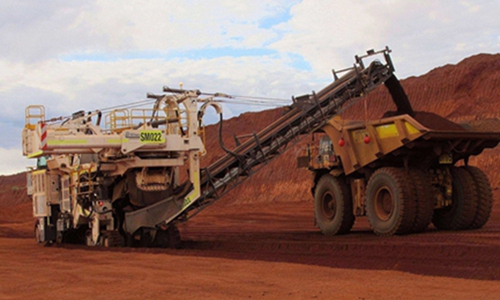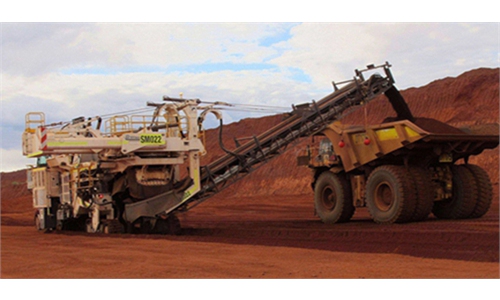SOURCE / INDUSTRIES
Industry insiders call for fair reporting amid soaring iron ore prices

An iron ore mining site in Australia Photo: cnsphotos
The blatantly misleading overseas media reports about Australia's iron ore trade with China have destabilized the market and possibly contributed to soaring prices, said industry insiders, who spoke of the need to avoid market panic as it will only bring unnecessary disruption for the supply chains on both sides.The Guardian reported on Sunday that Australia's losses from trade tensions with China are being offset by rising iron ore prices, which followed by another report by the Daily Mail suggesting Australia could put a levy on iron-ore exports to China.
China's steelmakers are understandably frustrated as they watch the price of iron ore - the commodity on which they are so dependent - soar into the stratosphere and eat away at their profits, the Sydney Morning Herald reported on Tuesday, noting that the most frustrating element is there is little they can do about it.
The report claimed that the soaring price is determined by supply and demand and one of the major reasons the price is rising so much is that China's appetite for iron ore is increasing faster than supply.
However, industry insiders said that although the bilateral tensions on both sides have caused rising market uncertainty, some provocative media reports have also played a negative role by adding fuel to the fire and destabilizing the situation more.
A source with Rio Tinto told the Global Times on Wednesday that there are cases of over-reporting and over-interpretation by the media when it comes to the iron ore exports, without elaborating on the details.
"Because of the tension in bilateral relations between China and Australia, there is indeed concern in the market, but there are also some people who take advantage of this opportunity to hype up the panic, which leads to higher prices," the source said, expressing concern that any disruption in trade will affect all the industry participants in the supply chain including Rio Tinto and Chinese traders.
As of Tuesday, spot iron ore prices had risen 36.8 percent since November, and by nearly 70 percent since the start of the year.
In response to the soaring prices, Luo Tiejun, vice president of the China Iron and Steel Industry Association, said on Friday in a video conference with Simon Farry, vice president of sales and marketing for Rio Tinto's iron ore business, that Rio Tinto has recently made continuous high-premium transactions on its platform, and the price increase has exceeded companies' expectations. The existing pricing mechanism is unreasonable, Luo said.
Since 2015, China has relied on imported iron ore for more than 80 percent of its supply. With steel prices up less than 15 percent since the start of the year compared with a big rise in iron ore prices, upstream cost increases are hard to digest.
The steel prices in 2017 and 2018 were not the highest in history, but at $70 or $80 per ton of iron ore, the steel enterprises were profitable, a Chinese steelmaker told the Global Times on condition of anonymity on Wednesday.
"Now the price has skyrocketed to $150 to 160. The profits of the whole industrial chain have been eaten up by the upstream. How can the downstream survive?" said the steelmaker.
Another reason for the high prices is the pricing mechanism, which has allowed the price to seriously deviate from the fundamentals of supply and demand, industry insiders said, noting that iron ore spot trading is based on the index pricing.
China continues to be the world's largest importer of iron ore, with a total of 1.06 billion tons imported in 2019. Of this, about 70 percent was from Australia and about 20 percent from Brazil, according to China Customs.
However, Brazil's ability to export iron ore has declined since the Tamsui Valley tailings dam collapsed in January last year, and Simandou, in Guinea, has yet to produce iron ore, so the Pilbara region of West Australia has become the main source of iron ore destined for China, media reports said.

